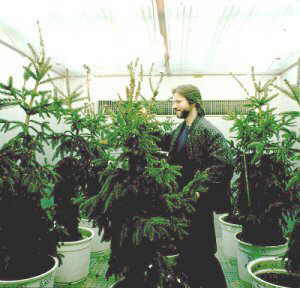|
||||||||||||||||||||||||||||||||||||||||||||||||||||||||||||||||||||||||||||||||||||||||||||||||||||||||||||||||||||||||||||
|
||||||||||||||||||||||||||||||||||||||||||||||||||||||||||||||||||||||||||||||||||||||||||||||||||||||||||||||||||||||||||||
| Norwegian Forest Research Institute (NISK) - Project Task | ||||||||||||||||||||||||||||||||||||||||||||||||||||||||||||||||||||||||||||||||||||||||||||||||||||||||||||||||||||||||||||
|
This partner will provide seeds
and plant material from full-sib families of Norway spruce produced after
controlled pollination and seed production in different environments to the
other
 partners
at the beginning of the project. Earlier experiments have shown that the
performance of these families as regards growth cessation and autumn frost
hardiness to a large extent depends on the temperature conditions during
the seed production. The other partners will investigate the mechanisms behind
these differences in performance by isozyme and molecular genetic
studies. partners
at the beginning of the project. Earlier experiments have shown that the
performance of these families as regards growth cessation and autumn frost
hardiness to a large extent depends on the temperature conditions during
the seed production. The other partners will investigate the mechanisms behind
these differences in performance by isozyme and molecular genetic
studies.
The first year we will do controlled pollination on Norway spruce grafts which are kept in eight phytotron rooms until the seeds are developed. Temperature and day length will be regulated in these rooms so that two rooms will have one of four climatic treatments, combining high and low temperatures and short and long days. Altogether five female and five male parents will be involved in these crosses. We will later test the seedlings from the seed lots produced from these full-sib families in artificial freezing tests. Seeds will also be distributed to the other project participants for isozyme and molecular genetic analyses.
In artificial freezing tests performed with
two-year-old seedlings from families and provenances ten years ago we selected
seedlings that survived temperatures of -6°C, -8°C and -12°C.
These seedlings were planted in a field test in 1993 together with seedlings
that had not been exposed to the low temperatures. In this experiment
measurements will be made of bud phenology, freezing tests of twigs will
be performed both in the spring and in the autumn and
A field trial was recently established with seedlings from seeds collected in spruce stands in Norway planted with provenances from Germany, Austria and Poland, and with seedlings from direct import of the same provenances. We will make measurements of the annual growth rhythm of this plant material to verify the early observations from freezing tests that a seemingly fast adaptation has taken place after one generation in the northern environment.
In a three-step approach we will test if
methylation of DNA is a possible molecular mechanism explaining the environmental
preconditioning phenomenon. The first step includes the use of northern and
immuno-blot analyses of phytochromes O and P. Seedlings of one full-sib family
will be studied under active growth and during growth cessation. If these
experiments reveal different
|
|||||||||||||||||||||||||||||||||||||||||||||||||||||||||||||||||||||||||||||||||||||||||||||||||||||||||||||||||||||||||||
| © 2001 ISOGEN |
|
|||||||||||||||||||||||||||||||||||||||||||||||||||||||||||||||||||||||||||||||||||||||||||||||||||||||||||||||||||||||||||
 physiological
measurements will be made. Vegetative tissue from the saplings will be
distributed to other project participants. Altogether this will make it possible
to estimate the genetic changes that has taken place in the population due
to the early selection for frost hardiness.
physiological
measurements will be made. Vegetative tissue from the saplings will be
distributed to other project participants. Altogether this will make it possible
to estimate the genetic changes that has taken place in the population due
to the early selection for frost hardiness.
 expression
patterns in progenies from a cold and a warm crossing environment, we will
continue by studying methylation patterns of the genes using Phy O and Phy
P as probes. If no difference in expression pattern appears, the next step
will be to screen an EST-library made from cDNAs of Norway spruce needles,
using macro- or microarray techniques. If positive, we will pick up genes
that are differentially expressed as a “memory” of the crossing
environment. Candidate genes will be used to develop new probes, which will
be used to study methylation patterns of the same genes. If this step fails,
we would try to develop a probe to study the general methylation pattern
of DNA from the full-sibs of the two contrasting crossing environments.
expression
patterns in progenies from a cold and a warm crossing environment, we will
continue by studying methylation patterns of the genes using Phy O and Phy
P as probes. If no difference in expression pattern appears, the next step
will be to screen an EST-library made from cDNAs of Norway spruce needles,
using macro- or microarray techniques. If positive, we will pick up genes
that are differentially expressed as a “memory” of the crossing
environment. Candidate genes will be used to develop new probes, which will
be used to study methylation patterns of the same genes. If this step fails,
we would try to develop a probe to study the general methylation pattern
of DNA from the full-sibs of the two contrasting crossing environments.
